
Mount Mica Update - 2005
Gary Freeman
Palm City, Fl 34991

As described in a prior update to the PIG site, late in 2004 we started to mine underground beginning in the SE corner of the main pit. An adit was started in essentially a southerly direction between the eastern pit face and a large bloom of lepidolite and pollucite in the southern quarry face. This area of intensification of the mineralization in the pegmatite had occurred just up strike or east of an abrupt, about 3m thickening of the peg. After advancing the adit for about 5-6m, we intercepted a water flow that eventually led us to pocket 28-04 (pocket number 28 of 2004). Pocket 28, the largest of the 3 large tourmaline bearing pockets we had found 2004, produced large tourmaline crystals and, as described by Simmons et. al. of the University of New Orleans, produced 4 species of tourmaline in a single pocket (schorl, elbaite, rossmanite and foitite). This was a first for North America. A 54cm tourmaline recovered from this same pocket may be North America’s largest. (For a more rigorous description of the geology of Mount Mica see the article in the Nov/Dec 2005 issue of "Rocks and Minerals", New Tourmaline Production from Mount Mica, Maine: America’s First Gem Pegmatite by William B. Simmons et al.)
By mid January we had nearly finished working 28-04. We had a loosely formed plan to attempt to work up strike and in the process mine down dip (SE) of pocket 28 and then mine behind it. Helping to tip the balance in this calculus was the discovery of a cavity in the E wall of the adit. We had used our drifter to make a series of probing holes in the pocket zone along the walls of our adit. We had also found a cavity in the southwestern wall but we believed this only to be a satellite cavity of 28. Let me digress here to add that the Mount Mica pegmatite, a sub horizontal sheet dipping approximately 20 degrees to the SE, is truly a sheet cake. Nearly mid way between the contacts the pocket zone resides just above the ‘garnet line’, a form of line rock. The garnet line, if in a well mineralized segment of the pegmatite, is generally within a matrix of cleavelandite which may contain beryl and cassiterite. Pocket signs are large pendant schorls surrounded by quartz, an increase in the cleavelandite mass with enlarged folia and lepidolite in small masses or stringers. During all of our mining to date, and from the accounts of others, the pegmatite has consistently presented in this fashion. Its ‘confection’ remains generally the same only locally waxing and waning in intensity. The big question, of course, was how much of the cake remained and what kind of ‘alteration’ to this happy story, if any, lay ahead.
Our previous mining had seemed to demonstrate a pattern for the pockets to enlarge as we worked down dip. In the spring of 2004 we had advanced the workings in the southwestern corner of the pegmatite 15 meters further down dip than any previous effort. In this corner we struck our other two large pockets, 7-04 and 11-04. With 28 mentioned above, these three pockets of 2004 probably rank in the top 5 in the pantheon of Mt. Mica pockets ranked by size. The Dagenais pocket of 1979, approximately 13 m in length, is Mt. Mica’s largest but because the tourmaline of this pocket had undergone extensive alteration, it was ranked as a non-tourmaline producer. Several large beryls were recovered however. The Loren Merrill pocket of 1903 also ranks amongst the 5 largest. Although perhaps not the best gem pockets, all three of the 2004 pockets were prolific tourmaline producers.
Hence, armed with this knowledge, both scientific and visceral, on January 12th we started a drift in the SE wall. We immediately opened pocket 1-05, the cavity we had intercepted with a probe hole. However winter soon shut us down, as the moisture seeping from the walls of our workings would quickly freeze. Daily our workings shrank as the ice built up. Heating had no affect.
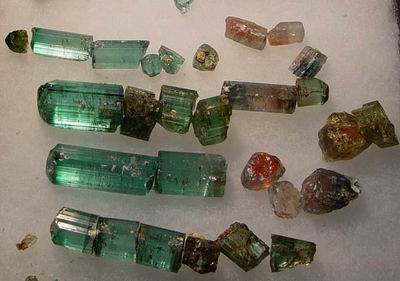
>After an impatient wait for the weather to warm, on March 15th we resumed working at Mount Mica. Within two days we had removed most of snow and ice and had pumped the pit nearly dry. We then set back to advancing our drift. Within a week we had found our 2nd pocket of ’05. As we had hoped, this pocket yielded some fine blue gem (see image). Although every tourmaline pocket we have opened at Mt. Mica has produced tourmaline of a different color, there seems to be a tendency for similar colors or color patterns to group into zones. For example, the pockets in the SW corner of the pit generally produced greens with dark terminations. Near the abrupt thickening mentioned above, the colors tended to pinks. Just to the east of the step the colors were various shades of blue. In fact, if we are in an area that is producing numerous closely spaced cavities, they will, in our pocket numbering system, carry the same pocket number if the tourmaline is of the same color. Also there appears to be little or no variation in color or color pattern for the tourmaline within a pocket. The termination type may vary but the color scheme is remarkably consistent.
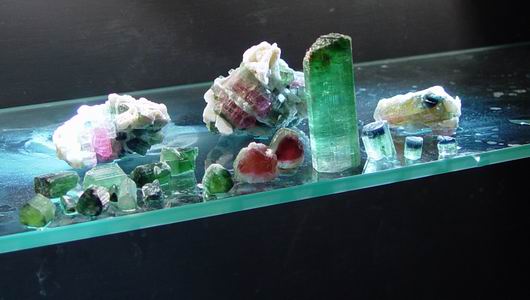
By the beginning of April we had advanced our drift 10 meters. Jim Clanin, a well known geologist and mining engineer from Southern California, joined Richard and I at this time. Jim has significant worldwide experience in gem prospecting and mining. He was most recently working at the Cryo-Genie Mine, Warren Springs, California. At the Cryo his work underground help produce many fine specimens of tourmaline and beryl. Jim had not been at Mount Mica for more than 2 days before we intercepted the leading edge of what was to be pocket 3-05. Initially we encountered only opaque tourmaline in small cavities and cookeite filled seams. Soon we opened the down dip side of a significant chamber. This chamber led to another within the left (north wall) of our drift that extended up dip for more than 1.5 meters. The next advance of our drift encountered pocket 4- 05 on the extreme down dip side of our drift. As we drove these last two advances, we found significant masses of lepidolite with spodumene. Unfortunately, we had expected the pegmatite to begin rising as we mined up strike, but the opposite proved to be the case. We were continually having to backup and drop our floor lower in order to advance the drift and successfully muck with our loader. As we did so, we explored the margins of these masses looking for pockets without a great deal of success. Pocket 4-05, which was located at the base of the down dip wall of our adit, led further down dip and then seemed to go back out the direction from which we had mined, but still within the wall. At this point our drift was less than 4m wide. Jim felt that the competency of the hanging wall roof would allow us to widen our drift by another 2-4 m.
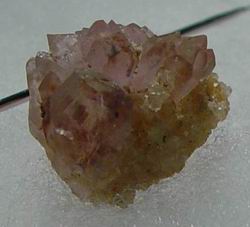
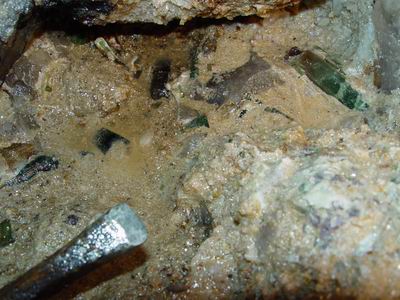
3m in from the entrance to our drift, we started the process of widening by taking an angled slice off of the down dip wall. Our first cut, to our surprise, opened pocket 5-5. This pocket although less than 0.8m long was a good gem producer. Its bottom contained 4-5 cm of clean cookeite sand. Within this sand nearly a dozen gem elbaite crystals or crystal sections of a light green blue were recovered. As we continued this widening process we encountered a series of pockets along the down dip side of our widening drift. Each contained, as all of the others in this drift, smoky quartz crystals, golden cookeite sand, and some elbaite. Pocket 7-5 was the exception by yielding two small groups of rose quartz crystals.
As we advanced the drift, we found the best practice to be the removal of all pegmatite to the hanging wall roof, a mica schist. The pegmatite, if left in the roof, had a nasty tendency to peel off along the contact. There is little or no alteration of the schist along the contact and almost no adhesion between the schist and the pegmatite. Therefore, checking the roof and scaling was a critical function that Jim assured took place. We also had to be careful not to drill into and blast the schist, as doing so would significantly weaken this otherwise competent rock. Our practice of following the hanging wall led us to our next item of ‘interest’. Generally as we worked up strike and in an easterly direction the roof had been descending at about 15-20 degrees. The same angle persisted on the right or down dip side of our workings. So, on each advance we adjusted our drilling to avoid penetrating the descending hanging wall. We were therefore quite surprised when at the 18m mark along our drift the hanging wall contact appeared to rise suddenly by 3-4m. The odd thing was that the garnet line that we had been following did not rise along with this apparent thickening of the pegmatite. What we did notice, however, was the emergence of a 2nd garnet line that did trend with this offset. The pattern was very reminiscent of what we had seen earlier out in the main pit. When the peg thickened rapidly there was a span where two garnet lines and in fact two pocket zones, one above the other, existed. In the main pit, as we mined up strike and away from this offset, a large zone of lepidolite emerged. This zone intensified as we worked this offset down dip and eventually there appeared spodumene crystals and a pod of pollucite incorporated with the lepidolite.
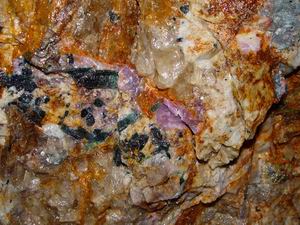
We speculated that perhaps this new ‘offset’ might follow the pattern of the one we encountered outside in the main pit. That is to say, soon we would encounter a zone of massive lepidolite, spodumene crystals and perhaps even pollucite. In fact, this pattern did hold. What we were not prepared for was the shear size of the body we were about to uncover. Although the zone started on a scale similar to the one we mined on the outside, in this case it continued to widen and thicken. We spent the entire month of June mining massive blocks of lepidolite and collecting spodumene fragments. Associated with this mineralization, and just on its down dip side, was an area of feldspar whose fractures were extensively filled with lollingite. Even this mineral was unusually abundant. Our expectations began to grow in lockstep with the mineralization. Perhaps we would encounter a very large pocket once we had breached the massive lepidolite.
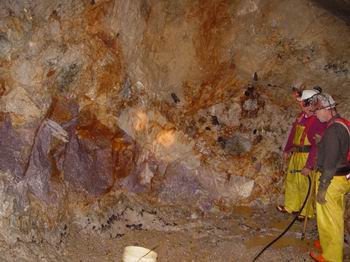
By July we had stockpiled tons of fine grained deep purple lepidolite. This material will be excellent for carving. More was still in the up dip side of our drift but taking more would have served no purpose at that time. Our plan required us to continue to turn the drift down dip and away from this lepidolite. Our skill at making the burn cut had improved so now we decided to drill 3m as opposed to 2m rounds. Once we had finished removing the pegmatite down to within a 1 meter or so of the garnet line we were ready to begin mining the mineralized zone.
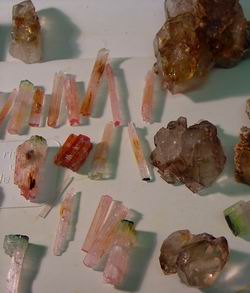
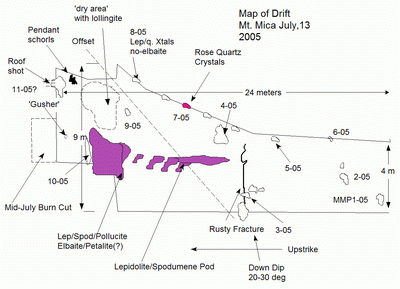
Our first bench, after our early July burn, yielded little. As we were drilling a second bench, our sinker drill dropped into a small cavity. Immediately, water began flowing rapidly from the hole. Attempting to evacuate the water with our blow pipe proved futile. By the next morning more than 500 gallons had collected in our drift. Pocket 28-04 started with a similar flow of water. Based on some scaling of the volume collected from 28, a 20 m3 pocket, we estimated the volume of this pocket, still undiscovered, to be on the order of 100 m3. What we did not anticipate was the amount of time, 2 weeks of hard mining, to find this chamber. In fact, as the water flow continued unabated throughout this time, we began to wonder whether we had not intercepted a pocket system but instead had tapped into some form of aquifer. Eventually though a series of small cavities began to emerge on the down dip side of our drift. At first these spaces, no more than a 0.3m high yet much wider, produced only poorly formed and opaque green tourmaline and simple milky quartz crystals. All of the productive pockets we have found at Mount Mica contained quartz crystals with gemmy secondary overgrowth. We hoped for this change soon.
On July 20 our small cavities abruptly enlarged to a respectable space. This new space, perhaps a meter square and of unknown depth, was lined with quartz crystals with promising overgrowth. Many schorls were embedded in the walls and roof which hinted at perhaps finding some respectable colored tourmaline within. The pocket material was about 0.3 m thick and heaped in a jumble on the floor of the pocket. All of this material was carefully screened. Besides an assortment of small gemmy green tourmaline there were fragments of a schorl that had evidently grown into the iron depleted environment of the pocket where it developed a bright pink section ending in a thin blue green cap. Although just in fragments, the material was gorgeous. The pink section had grown in what appeared to be channels aligned with the C axis of the crystal. Shining a light down this long axis produced an intense pink color that behaved remarkably like fiber with its complete internal refection.
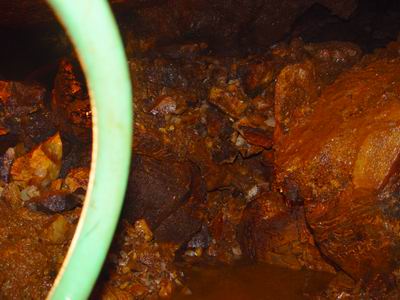
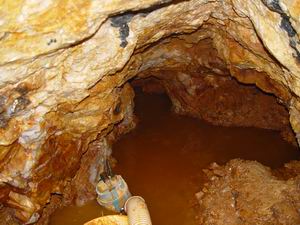
As we worked to the back of this chamber, a distance of approximately 1m, it appeared to end in a solid wall of quartz crystals, their points projecting into the floor. A little digging under these points showed promise of another space beyond. We had no choice at this point but to drill a few, hopefully well located, holes in order to explore beyond. Using a minimum of explosive, we shot them. The quartz at the back shattered completely, as expected, and revealed a similar sized chamber beyond. Although we found no more of the wonderful pink material, we found many gemmy green tourmalines and a beryl on matrix. This chamber too ended in a curtain of quartz. Once more we drilled and shot a few holes. Another small cavity opened up with a suspicious opening at the back. After emptying this new chamber, and increasingly Houdini like feat to dig it out, we thrust a 1 meter nylon par into the softball sized aperture at the far back. It entered easily. For the third time we shot the roof of the cavity. This time though rather than revealing a 1m sized space, an immense pocket was exposed. The debris mound reached nearly to the ceiling and the space seemed to go at least 3 to 4 m to the left and to the right. Quartz crystals to a meter in length were piled in every direction. Like pocket 28-04 the span of the pocket was so long, large pieces of the roof had collapsed as massive plates. In the photo several large quartz crystals can be seen with their points projecting down with large pieces of the roof still attached to their bases. Each of these crystals was approximately 0.8 m in length.
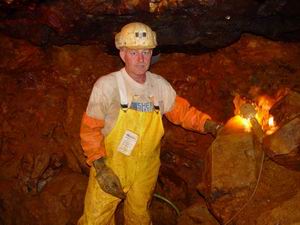
Like all large pockets at Mount Mica, this one was wet and rusty. We had no clue when we first opened it as to its extent and especially its depth. If this pocket was to be of reduced height, the going would be rough. We need not have worried though, for after two weeks of straight in excavation following the pocket wall down from our entrance point we had still not reached a firm bottom. Though still standing on pocket material, the roof was more than 2m above the bottom. As we worked into the pocket it tapered as it went down and eventually worked its way under the opposing pocket wall. It seemed that our best gem material was coming from these narrow cookeite filled and perpetually water filled spaces at the bottom of the pocket. Although the best gem was emanating from the bottom, two major specimens from 11-05 were once attached high on this near vertical wall. The wall itself was comprised on quartz crystals, cleavelandite and lepidolite. The two pieces, a 36cm x10cm tabular pale beryl with cleavelandite and minor tourmaline and 20cm elbaite on cleavelandite, were found next to each other and against the wall.
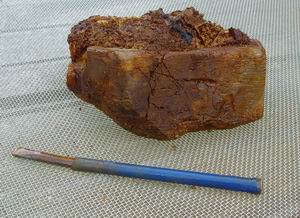
Excavation of the pocket continued for 7 weeks to the beginning of September. Although still not completely explored, the pocket had gained the upper hand exhausting the miners. More than 50 kg of tourmaline had been recovered and a 40 feet ocean freight container had been filled nearly to capacity with quartz crystals and matrix elbaite specimens. By then the dimensions of the pocket were 13m x 3m x 2.5m. A welcomed but unproductive 8 week diversion to work another locality in the sunshine followed.
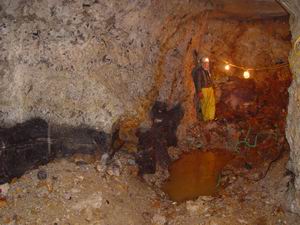
By the beginning of November, we resumed work at Mt. Mica. The plan then was to mine up dip of the pocket and then attempt to mine in behind it (down dip) so as to better work the low and tapered part of the pocket and work down dip before make a reversal and mining parallel to our established drift. To our surprise, as we started advancing our drift up dip, we intercepted a large xenolith of schist. The xenolith, though not completely explored by the end of 2005, appears to be approximately 6m square and from 1-2m thick. Its margins are heavily altered. There is more than 4m of pegmatite above the xenolith and exploratory drilling shows at least this much below. The upper surface was folded up like a leaf indicating perhaps that perhaps it had settled into the pegmatite from the hanging wall. The down dip side of the xenolith borders pocket 11-05. As we reached the up strike or eastern end of the mass, 3m probing drill holes intercepted pocket in two holes drilled 2m apart. It is probable that this new pocketing is an extension of 11-05. It is interesting to note that as we excavated out in the open pit, a slightly smaller xenolith was encountered just down dip and slightly up strike of the Dagenais pocket of 1979. This pocket, based on descriptions provided by Rene Dagenais, its discoverer, is just slightly longer than 11-05 at 14m. The Dagenais xenolith was emplaced just to the west of the stepwise thickening of the pegmatite noted above. There now seems to be a speculative correlation between the large pockets at Mt. Mica and local disturbances in the pegmatite dynamics induced by these masses. It will be interesting to see if there is a significant change in the pegmatite thickness east of this mass.
Another observation of interest is that the mineralized or core zone seems to be advancing at a constant dip of about 25 degrees SE and is uninfluenced by localized differences in pegmatite thickness and contour. In fact we speculate now that the zenolith may have played a part in the abrupt thickening of the pegmatite. In may have detached from the upper contact creating an extra volume that was in filled by the pegmatite.
We have now advanced our drift nearly 40% of the way to the far eastern and supposedly poorly mineralized Irish or New Mount Mica pit. Our observations underground are not inconsistent with the hypothesis proposed by Hurlburt and Wenden in their 1951 article in the American Mineralogist, Beryl of Mount Mica, Maine, describing beryl of unique morphology removed from a large pocket in the Irish workings. Their view was that the dip of the Mount Mica pocket zone would extend beneath the Irish workings and this zone had only been intercepted as the Irish pit was excavated lower and the beryl pocket struck. If their view is correct, and as they noted, this would imply that the Mount Mica gem deposit is substantially large than previously imagined. Almost each mining effort in the past has been ended with an obituary of the pegmatite. Our work thus far indicates there may be a few interesting chapters left in the Mount Mica story.